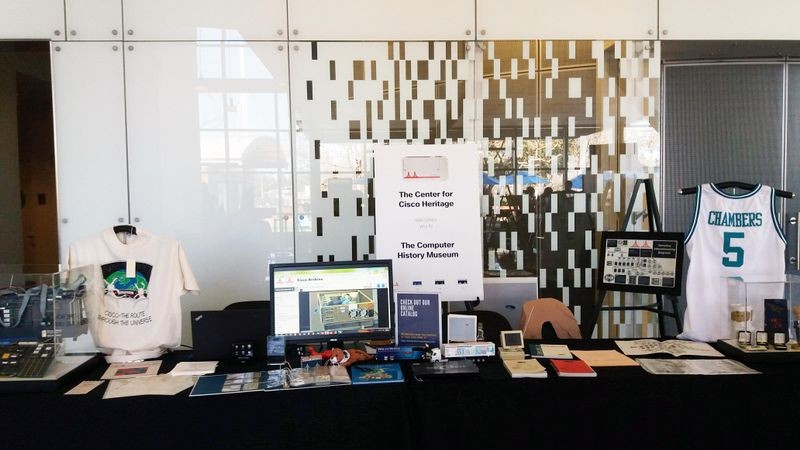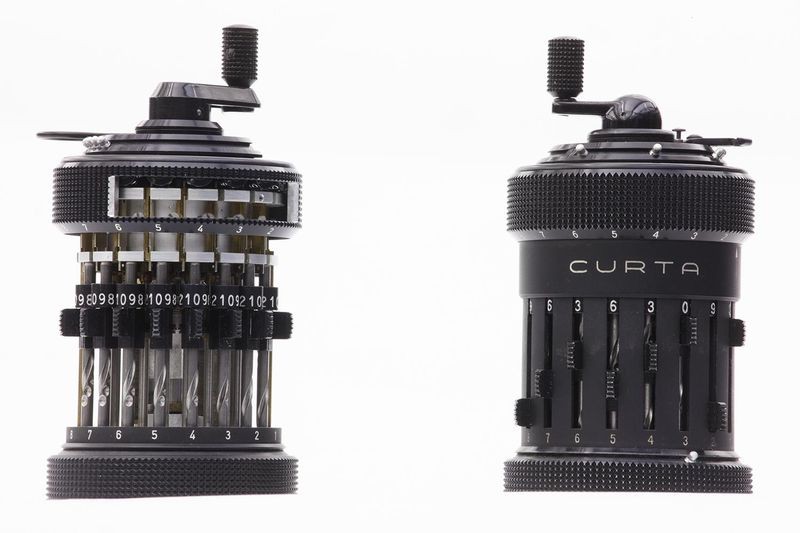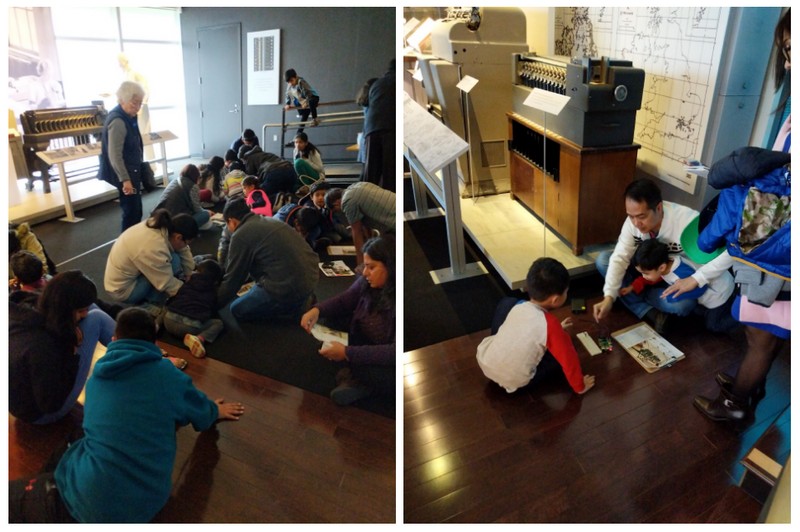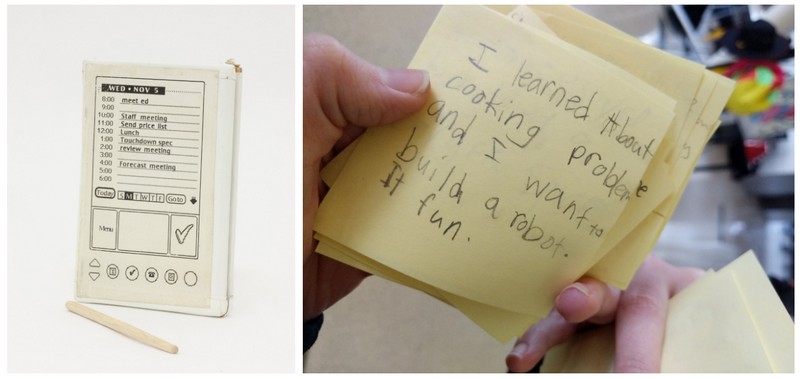
On February 24 and 25, the Computer History Museum (CHM) hosted Cisco Weekend—one of CHM’s many Partner Weekends that provides employees of corporations that support the Museum and their families and friends a day of fun and learning at CHM for free.
This Cisco Weekend drew a record-breaking 2,311 Cisco visitors and guests in addition to the Museum’s regular weekend visitors. Events like this are not only a wonderful way for our staff to connect with the Silicon Valley community around us, but also an opportunity for the Museum to share its wonderful family and community programming with a larger audience through our Teen Internship Program.

Center for Cisco Heritage booth during Cisco Weekend at the Computer History Museum, February 24 and 25, 2018.
Many visitors’ first stop was the Cisco Heritage booth. The Center for Cisco Heritage is an ongoing four-year collaboration between the Museum and Cisco Systems. Paula Jabloner, director for the Center for Cisco Heritage and CHM’s director of digital collections, encouraged visitors to learn about Cisco’s long history in Silicon Valley through a number of artifacts, including the famous Border Gateway Protocolnapkin, often referred to as the “two-napkin protocol” created by Kirk Lougheed (Cisco) and Yakov Rekhter (IBM). Recreations of the protocol were printed on souvenir napkins. Guests were also greeted by Stephanie Waslohn, archivist for the Center for Cisco Heritage. Jabloner and Waslohn provided visitors further insight into Silicon Valley’s rich corporate history and gave Cisco employees a chance to learn more about their company’s history and culture.
CHM’s Education Department also offered several family activities that encourage intergenerational explorations of computers and their history. Across from the Center for Cisco Heritage booth, visitors were greeted by volunteers from our Teen Internship Program. These high school students go through a rigorous selection and interview process, followed by several weeks of training with our education specialist, Emily Stupfel, who teaches them about our family programs and how to make the Museum a place for families to learn and be together. Her work to make CHM a community hub was seen in action this weekend through our many family experiences available.
Throughout the weekend, the teen-managed Exploration Station was bombarded by excited kids, full of questions. The long table displayed a number of carefully selected artifacts for guests to pick up, touch, and even use! The Exploration Station featured artifacts like a mechanical calculator from 1913, an abacus, a slide rule, the Curta calculator, and a fully functional IBM 26 Key Punch. This last artifact was one of the most popular attractions, as children could punch their names or a message into a card to keep as a memento. Our interns were ready to explain the stories and uses behind each of the artifacts and to provide computing touch points for children and adults alike.

Curta calculator, 1950-1960s. The Curta calculator has deep connections with larger historical movements. This small, cylindrical calculator can fit in your palm and is operated by a series of slides and cranks. The Curta’s inventor, Curt Herzstark, was an Austrian engineer who finally found the courage to pursue his designs while interned at the Buchenwald concentration camp during World War II. Allowing children to physically interact with objects like these illuminates history. Collection of the Computer History Museum, 102626591.
Ideas and themes embedded in our computing artifacts—some of which are over 200 years old!—were also made accessible through our Family Activity Stations. These stations cater to visitors of all ages and are offered on select Saturdays from 11 a.m. to 4 p.m. Here, families can work together to innovate and create their own experiments, making meaningful connections to computer history. One of the stations was dedicated to Herman Hollerith’s tabulating machine, first built in 1888. It was developed to calculate the results from the 1890 US Census, when 63 million people lived in our country. The central technology behind this machine is a simple circuit technology that is ubiquitous today but on a much smaller scale. Using Raspberry Pi computers, breadboards, jumper wires, and other materials, families built their own circuits to turn on an LED light bulb—right next to Hollerith’s machine. “I think it was great,” one visitor said. “I had to try two times, but I finally got it!”

Families learn about circuit technology using Raspberry Pi computers, jumper wires, and other materials near the Hollerith Machine in Revolution: The First 2000 Years of Computing.
Teen interns also led families in activities that focused on the importance of prototyping. Interns guided participants through the design process and provided materials to help them build physical models of their ideas near the PalmPilot display in our Mobile Computing gallery, which includes an early wooden prototype of the PalmPilot built by Palm cofounder Jeff Hawkins in ca. 1995. “This is a very effective activity for inspiring kids to think, imagine, and have hands on prototyping workflow,” said a parent participant. When asked how technology could help them solve a problem in their life, participants came up with a variety of ideas, like a cooking robot or a “happiness generator.” The latter was envisioned as a “floating-type” robot that uses facial recognition to learn users’ emotions and help cheer them up when they’re feeling sad. “The gallery activities made kids stop, think, participate, and brainstorm an idea,” said another guest.

Left: Jeff Hawkins tested the PalmPilot’s design with this model, using a chopstick for a stylus. He took pretend notes in meetings, and counted the steps it took to perform common tasks. Collection of the Computer History Museum, 102716262. Right: Activity feedback from one of our young participants.
For guests who preferred to set their own pace, the Education Department also gave visitors a self-guided family activity. Designed for families with younger children, these handouts asked visitors to be on the lookout for three objects in each of our gallery spaces. When they found them, kids could engage more with the artifact through questions and by drawing prompts that helped connect each artifact to something in their own life.
Community and family programming, like our Exploration Stations and family tours and activities stations are offered most Saturdays. Call ahead to check our offerings. In combination with our demonstration labs, where we feature a fully functional PDP-1 and an IBM 1401 restored and operated by a team of dedicated volunteers, CHM is more than a museum—it is a community hub where visitors of all ages can experience history and make connections with the technology they use in their own lives. We especially enjoyed sharing our educational programming with the Cisco community.
The Center for Cisco Heritage is an ongoing four-year collaboration between the Computer History Museum and Cisco Systems. For more information on the project, visit computerhistory.org/ciscoarchive/ or contact heritage@cisco.com.
CHM is grateful to Cisco and the many other corporations that support the Museum.